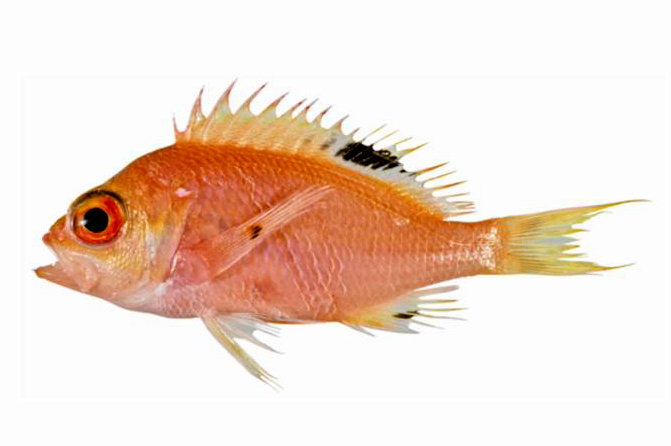Western Orange Perch, Lepidoperca filamenta Roberts 1987

Western Orange Perch, Lepidoperca filamenta. Source: Australian National Fish Collection, CSIRO. License: CC BY Attribution-Noncommercial
Summary:
A pinkish-orange rock-cod often becoming pale pink below with a lunate tail and an indistinct pale pink stripe from the upper jaw to the lower part of the gill cover. Males have a large black blotch on the anterior part of the soft dorsal fin, a small dark blotch on the middle of the pectoral fins, and another dark blotch on the middle of the anal fin. Females have blackish tips on the soft parts of the dorsal and anal fins.
Cite this page as:
Bray, D.J. 2019, Lepidoperca filamenta in Fishes of Australia, accessed 20 Apr 2024, https://fishesofaustralia.net.au/home/species/1713
Western Orange Perch, Lepidoperca filamenta Roberts 1987
More Info
|
Distribution |
Endemic to southern Australia from south of Port Lincoln, South Australia, to off Geraldton, Western Australia. Inhabits deep reefs at depths to 230 m. |
|
Features |
Dorsal fin X, 16-17; Anal fin III, 8; Caudal fin 17; Pectoral fin 15; Pelvic fin I, 5; Lateral line scales (pored) 39-43; Upper transverse scale rows 4, lower transverse scale rows 12-14; Gill rakers 9-10 + 24-27 = 33-37. Body depth 38-44% SL; head length 34-39% SL; eye diameter 33–42% HL; upper jaw length 2.08-2.43 in HL; maxilla reaching to below middle of pupil. Caudal fin lunate, dorsal lobe 0.83-1.10 in HL; pelvic fin long, 2.44-2.90 in SL; basal part of spinous dorsal fin scaled; axil of pectoral fin scaled. |
|
Fisheries |
The species is occasionally on hook and line, and as bycatch in commercial trawls. |
|
Similar Species |
Lepidoperca filamenta differs from the similar Eastern Orange Perch, Lepidoperca pulchella in having fewer scales in the upper transverse series (4 vs. 5), a longer caudal fin (dorsal lobe 0.83-1.10 vs. 1.17-1.41 in HL), and a small dark blotch at the centre of anal and pectoral fins (vs. absent). In addition, modal differences are found in the following characters: pored lateral line scales (39-43 vs. 42-45), gill rakers on lower arch (24-27 vs. 26-30), bony orbit diameter (2.40-3.02 vs. 2.60-3.54 in HL), upper jaw length (2.18-2.43 vs. 2.28-2.54 in HL), longest anal soft ray (1.27- 1.74 vs. 1.68-2.48 in HL) and pelvic fin length (2.88-3.38 vs. 3.18-3.88 in SL). |
|
Etymology |
The specific name is from the Latin filum (thread) and mentum (forming), in reference to the long filamentous rays of the caudal fin lobes. |
|
Species Citation |
Lepidoperca filamenta Roberts 1987, Mem. Mus. Vic. 48(1): 83. Type locality: west of Eucla, Great Australian Bight, Western Australia [32°20'S, 128°00'E]. |
|
Author |
Bray, D.J. 2019 |
|
Resources |
Western Orange Perch, Lepidoperca filamenta Roberts 1987
References
Roberts, C.D. 1987. New Australian fishes. Part 19. A new species of Lepidoperca (Serranidae). Memoirs of Museum Victoria 48(1): 83-84. DOI https://doi.org/10.24199/j.mmv.1987.48.19 PDF available, open access
Roberts, C.D. 1989. A revision of New Zealand and Australian orange perches (Teleostei; Serranidae) previously referred to Lepidoperca pulchella (Waite) with description of a new species of Lepidoperca from New Zealand. Journal of Natural History 23(3): 557-589. https://doi.org/10.1080/00222938900770321
Roberts, C.D. & Gomon, M.F. 2008. Families Polyprionidae, Serranidae and Callanthiidae. pp. 534-549 in Gomon. M.F., Bray, D.J. & Kuiter, R.H (eds). Fishes of Australia's Southern Coast. Sydney : Reed New Holland 928 pp.


